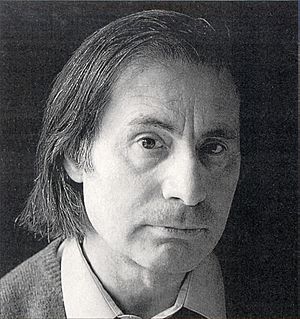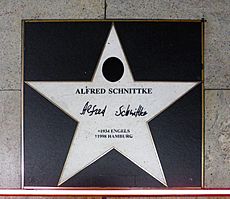Alfred Schnittke facts for kids
Alfred Schnittke (born November 24, 1934 – died August 3, 1998) was a famous Soviet and German composer. He wrote many different kinds of music.
Schnittke's early music was influenced by another great composer, Dmitri Shostakovich. Later, Schnittke created his own special way of composing called "polystylism". This meant he mixed many different musical styles in his works.
Some of his most important pieces include his long First Symphony and his first concerto grosso. In the 1980s, his music became very popular around the world. He wrote many pieces during this time, like his string quartets, the ballet Peer Gynt, and several symphonies and concertos.
Life and Career of Alfred Schnittke
Alfred Schnittke was born in Engels, a city in Russia, in 1934. His father was Jewish and worked as a journalist. His mother was a Volga German from Russia.

Schnittke started learning music in 1946 in Vienna, Austria. His father was working there at the time. Schnittke loved Vienna because he felt connected to the city's rich musical history. He felt that famous composers like Mozart and Schubert helped shape his musical taste.
In 1948, his family moved to Moscow, Russia. Schnittke studied composition at the Moscow Conservatory and later taught there. He also wrote music for almost 70 movies to earn a living. Schnittke became a Christian and his deep beliefs influenced his music.
The Soviet government sometimes viewed Schnittke's music with suspicion. For example, his First Symphony was not allowed to be performed for a while. In 1980, he was not allowed to travel outside the Soviet Union.
In 1985, Schnittke became very ill and fell into a coma. Doctors thought he might not survive, but he recovered. He bravely continued to compose music even after his illness.
In 1990, Schnittke moved from the Soviet Union to Hamburg, Germany. His health remained poor, and he had more strokes. He passed away on August 3, 1998, at the age of 63. He was buried in Novodevichy Cemetery in Moscow, where many other famous Russian composers are also buried.
Alfred Schnittke's Music Style
Schnittke's early music sounded a lot like the music of Dmitri Shostakovich. But after meeting Italian composer Luigi Nono, Schnittke tried a new style called serialism. However, he soon found this style too limiting.
He then created his own unique style called "polystylism". This meant he would mix different musical styles, from old classical music to modern sounds, all in one piece. He once said his goal was to combine serious music with lighter music.
His first piece using polystylism was his second violin sonata, Quasi una sonata. He even tried out these ideas in his music for animated films. He continued to develop this style in big works like his First Symphony and First Concerto Grosso.
Some of his works were more unified in style, like his piano quintet. He wrote this piece to remember his mother after she passed away.
In the 1980s, more people outside the Soviet Union discovered Schnittke's music. This was partly thanks to musicians like Gidon Kremer. Even though he was often sick, he wrote a lot of music. This included his Second and Third String Quartets, the ballet Peer Gynt, and several symphonies and concertos.
During this time, Schnittke's music also started to include more Christian themes. You can hear this in his choral works like the Concerto for Mixed Chorus and the Penitential Psalms.
Schnittke's Ninth Symphony was a very challenging piece. He was very ill when he wrote it, and it was hard for others to understand his notes. After he died, other composers helped to finish and arrange it so it could be performed.
Images for kids
-
Gravestone, showing a fermata over a whole rest marked fff
See also
 In Spanish: Alfred Schnittke para niños
In Spanish: Alfred Schnittke para niños




